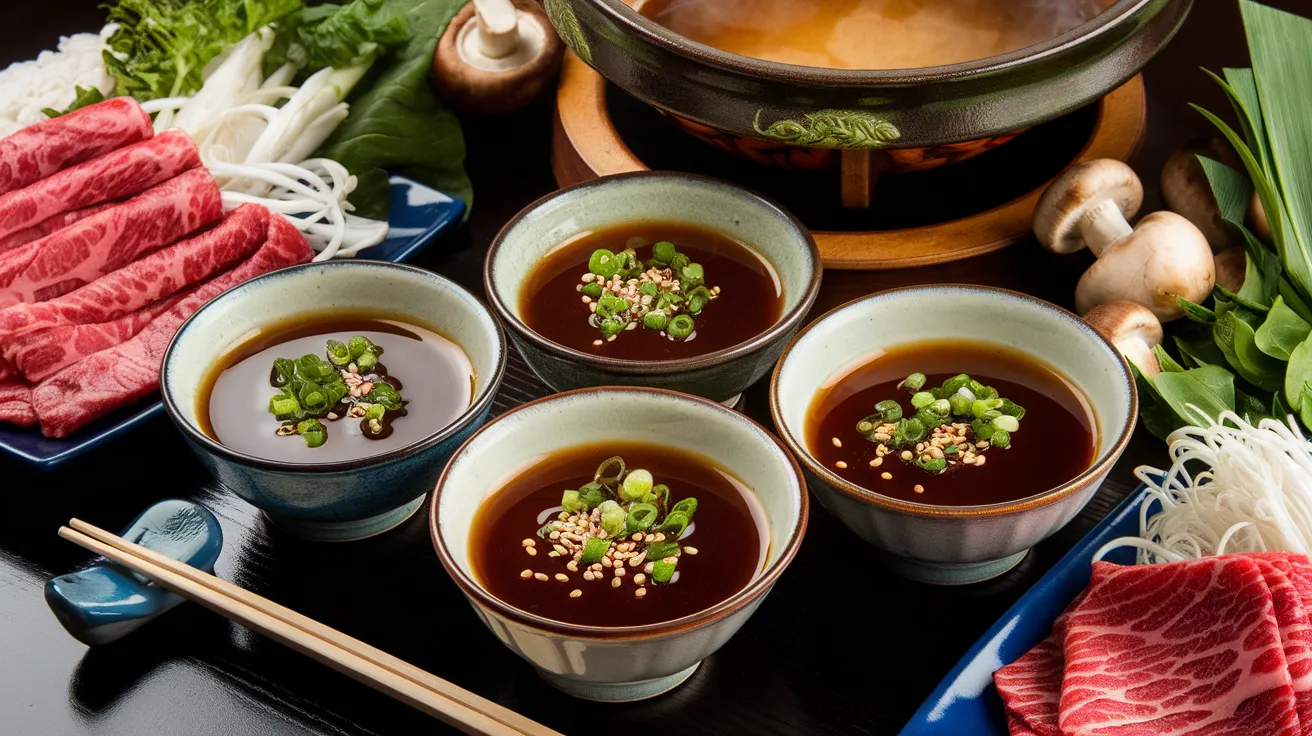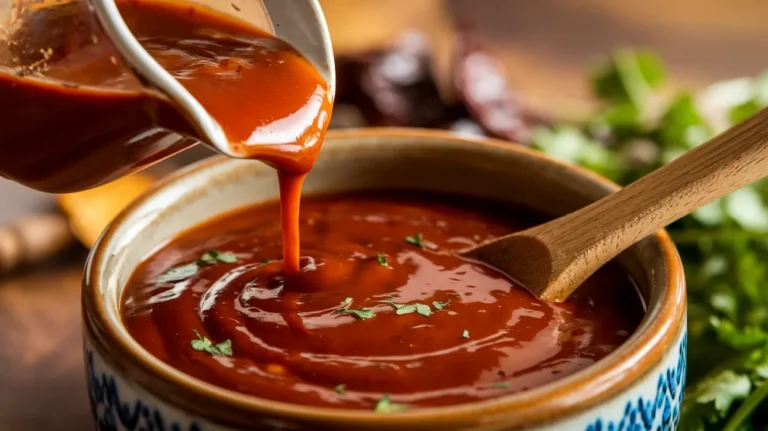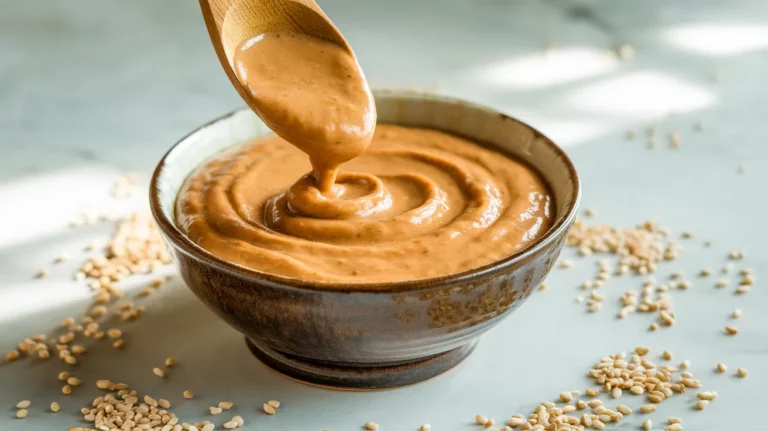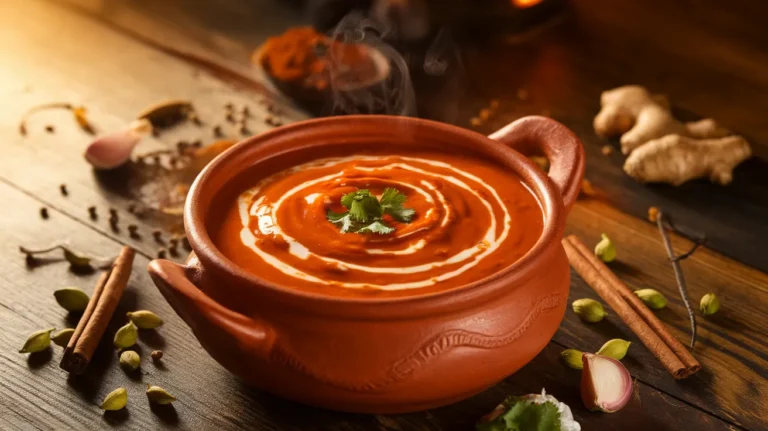This authentic shabu-shabu dipping sauce transforms your Japanese hot pot experience with its perfect balance of umami, citrus, and heat. Our foolproof recipe creates restaurant-quality shabu-shabu dipping sauce that enhances every bite of tender meat and fresh vegetables in just minutes.
SERVES: 4 | PREP: 10 MIN | COOK: 5 MIN | TOTAL: 15 MIN
Essential Ingredients
Base Sauce Components
| Ingredient | Amount | Notes |
|---|---|---|
| Soy sauce (low sodium) | 1/2 cup | Forms the umami foundation |
| Rice vinegar | 3 tablespoons | Adds bright acidity |
| Mirin | 2 tablespoons | Sweet rice wine for balance |
| Sesame oil | 1 tablespoon | Rich, nutty flavor |
Flavor Enhancers
| Ingredient | Amount | Notes |
|---|---|---|
| Fresh ginger | 2 teaspoons, grated | Use microplane for best texture |
| Garlic | 2 cloves, minced | Fresh only, no powder |
| Green onions | 3 stalks, finely chopped | Reserve some for garnish |
| Toasted sesame seeds | 2 tablespoons | Toast yourself for maximum flavor |
Optional Heat & Citrus
| Ingredient | Amount | Notes |
|---|---|---|
| Yuzu juice or lime juice | 1 tablespoon | Adds bright citrus notes |
| Chili oil with sediment | 1-2 teaspoons | Adjust to taste preference |
| White pepper | 1/4 teaspoon | More aromatic than black pepper |
Step-by-Step Shabu-Shabu Dipping Sauce Instructions
Phase 1: Preparation Setup (3 minutes)
Step 1: Gather all ingredients and measure them into small bowls. This shabu-shabu dipping sauce comes together quickly, so having everything ready prevents rushing and ensures perfect proportions.
Step 2: Grate fresh ginger using a microplane or finest grater setting. Fresh ginger provides the sharp, clean bite that defines authentic shabu-shabu dipping sauce. Avoid pre-grated ginger as it lacks the essential oils.
Step 3: Mince garlic cloves finely using a sharp knife. Press down with the flat side of your knife first to release oils, then mince. The garlic should be nearly paste-like for the smoothest sauce texture.
Phase 2: Toasting Aromatics (2 minutes)
Step 4: Heat a small dry skillet over medium heat. Add sesame seeds and toast for 1-2 minutes, shaking the pan frequently. You’ll hear them start to pop and smell their nutty aroma when ready.
Step 5: Remove toasted sesame seeds immediately to a plate to stop cooking. Overtoasted seeds become bitter and will ruin your shabu-shabu dipping sauce balance.
Phase 3: Sauce Assembly (5 minutes)
Step 6: In a medium mixing bowl, combine soy sauce and rice vinegar first. Whisk together to create the acidic base that will balance the richness of your shabu-shabu dipping sauce.
Step 7: Add mirin and sesame oil, whisking constantly. The mirin adds sweetness that counteracts the salty soy sauce, while sesame oil provides the characteristic nutty depth.
Step 8: Stir in grated ginger and minced garlic thoroughly. These aromatics need to distribute evenly throughout the sauce for consistent flavor in every spoonful.
Step 9: Add three-quarters of the chopped green onions, reserving the rest for garnish. The green onions provide fresh, mild onion flavor and beautiful color contrast.
Phase 4: Final Seasoning (3 minutes)
Step 10: Taste your shabu-shabu dipping sauce and adjust seasoning. It should taste balanced – salty, sweet, acidic, and aromatic. Add more soy sauce for saltiness, mirin for sweetness, or vinegar for brightness.
Step 11: Stir in yuzu or lime juice gradually, tasting as you go. The citrus should brighten the sauce without overpowering the other flavors. Fresh citrus makes a noticeable difference over bottled juice.
Step 12: Add chili oil if using, starting with just 1/2 teaspoon. The heat should complement, not dominate your shabu-shabu dipping sauce. Remember, you can always add more but can’t take it away.
Phase 5: Finishing Touches (2 minutes)
Step 13: Sprinkle in white pepper and mix well. White pepper has a more complex, aromatic heat than black pepper and won’t create dark specks in your sauce.
Step 14: Add half the toasted sesame seeds to the sauce, reserving the rest for garnish. Mixing some seeds in creates texture while keeping some whole seeds for visual appeal.
Step 15: Let the shabu-shabu dipping sauce rest for 5 minutes to allow flavors to meld. This resting time is crucial for the aromatics to infuse properly throughout the sauce.
Chef’s Notes
Umami Balance: The key to exceptional shabu-shabu dipping sauce lies in balancing the five taste elements. Start with our base recipe, then adjust each component gradually until you achieve the perfect harmony for your palate.
Freshness Factor: Always use fresh ginger and garlic rather than pre-prepared versions. The volatile oils in fresh aromatics create the bright, clean flavors that distinguish restaurant-quality shabu-shabu dipping sauce from ordinary versions.
Make-Ahead Advantage: This sauce actually improves after sitting for 30 minutes as the flavors marry together. Prepare it before starting your hot pot setup for the most developed taste.
Consistency Control: If your sauce seems too thin, add an extra tablespoon of sesame oil. For thinner consistency, add rice vinegar one teaspoon at a time until you reach desired thickness.
Nutrition Information (Per Serving)
- Calories: 45
- Protein: 2g
- Carbohydrates: 4g
- Fat: 3g
- Sodium: 920mg
- Fiber: 1g
Delicious Variations
Spicy Miso Version
Add 1 tablespoon of white miso paste and extra chili oil for a richer, more complex shabu-shabu dipping sauce. The miso adds incredible depth and saltiness that pairs beautifully with beef.
Citrus-Forward Style
Increase yuzu juice to 2 tablespoons and add 1 teaspoon of lemon zest. This bright version cuts through rich meats perfectly and works especially well with seafood hot pot ingredients.
Sesame-Heavy Variation
Double the sesame oil and add 1 tablespoon of tahini for an intensely nutty shabu-shabu dipping sauce. This variation pairs exceptionally with our sukiyaki sauce for mixed Japanese dining experiences.
Ponzu-Inspired Blend
Replace half the soy sauce with ponzu and add extra citrus. This creates a lighter, more refreshing dipping sauce similar to traditional ponzu but with the body needed for shabu-shabu. Try it alongside yakisoba sauce for a complete Japanese flavor profile.
Storage & Reheating Guidelines
Refrigerator Storage: Store your shabu-shabu dipping sauce in an airtight container for up to one week. The flavors actually develop and improve over the first 2-3 days of storage.
Freezing Instructions: This sauce freezes well for up to 3 months. Freeze in ice cube trays for portion-controlled servings, then transfer cubes to freezer bags for easy use.
Serving Temperature: Serve at room temperature for best flavor development. Remove from refrigerator 15-20 minutes before serving to allow aromatics to bloom properly.
Reheating Notes: Never heat this sauce as it will destroy the fresh aromatics and create a harsh taste. Simply stir well and serve at room temperature.
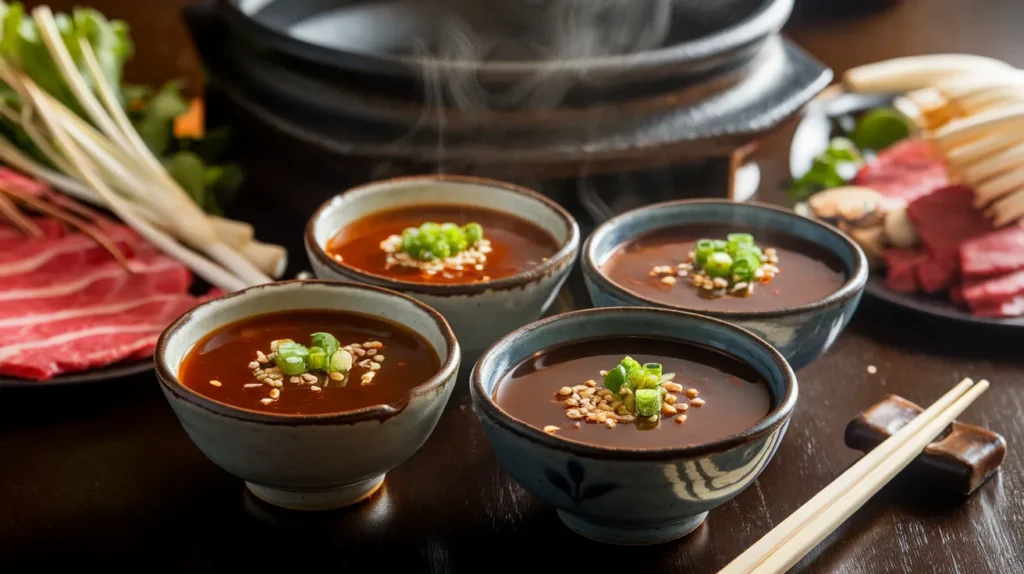
Troubleshooting Common Issues
Problem: Sauce Tastes Too Salty
Solution: Add 1-2 teaspoons of mirin and a splash of rice vinegar. The sweetness and acidity will balance the saltiness without diluting the flavor intensity of your shabu-shabu dipping sauce.
Problem: Lacking Depth and Complexity
Solution: Check that you’re using low-sodium soy sauce and fresh aromatics. Add a pinch of white pepper and let the sauce rest longer for flavors to develop properly.
Problem: Too Thin or Watery
Solution: Add more sesame oil gradually, whisking constantly. Alternatively, let the sauce sit uncovered for 10 minutes to allow some moisture to evaporate naturally.
Problem: Overwhelming Ginger Heat
Solution: Balance with extra mirin and a touch more sesame oil. Next time, use less ginger or grate it more coarsely to reduce the intensity in your shabu-shabu dipping sauce.
Problem: Sauce Separates When Standing
Solution: This is normal due to the oil content. Simply whisk vigorously before serving. For better emulsion, add ingredients in the order specified in our recipe.
Equipment Essentials
- Microplane grater – Essential for properly grated ginger
- Small whisk – For smooth sauce consistency
- Fine-mesh strainer – Optional, for ultra-smooth sauce
- Small skillet – For toasting sesame seeds
- Glass mixing bowl – Won’t absorb flavors like plastic
- Airtight storage containers – For proper sauce storage
Shopping List by Store Section
Asian/International Aisle
- Low-sodium soy sauce
- Rice vinegar
- Mirin (sweet rice wine)
- Sesame oil
- Chili oil with sediment
- Yuzu juice (if available)
Fresh Produce
- Fresh ginger root
- Garlic bulbs
- Green onions
- Fresh lime (yuzu substitute)
Spice/Baking Section
- Sesame seeds (or pre-toasted)
- White pepper
Success Secrets
1. Always taste and adjust your shabu-shabu dipping sauce before serving. Each brand of soy sauce varies in saltiness, so final seasoning is crucial for perfect balance.
2. Toast sesame seeds yourself rather than buying pre-toasted versions. Freshly toasted seeds have significantly more flavor and aroma that enhances the overall sauce quality.
3. Use a 2:1 ratio of soy sauce to rice vinegar as your base, then adjust other ingredients proportionally. This creates the perfect foundation for authentic shabu-shabu dipping sauce.
4. Prepare sauce 30 minutes before serving when possible. The resting time allows all flavors to marry and creates a more cohesive, restaurant-quality taste.
5. Keep extra sauce ingredients on hand for quick adjustments. Having small amounts of each component ready lets you fine-tune the flavor profile to match different proteins and vegetables in your hot pot.
